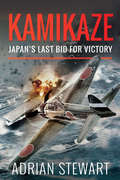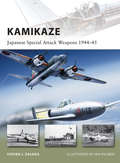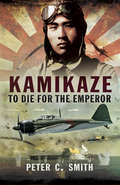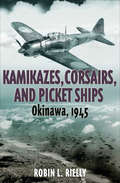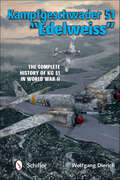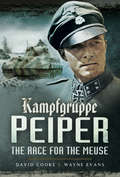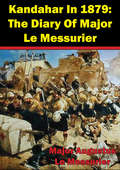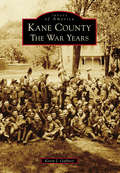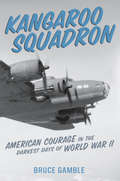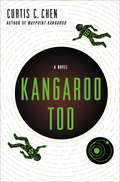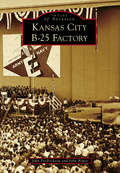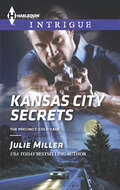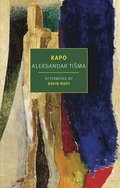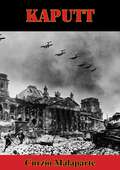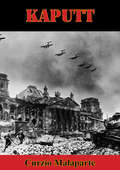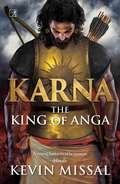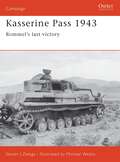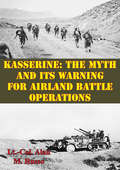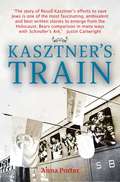- Table View
- List View
Kamikaze: Japan's Last Bid for Victory
by Adrian StewartThis enlightening WWII history examines Japans Kamikaze Corps of special forces pilots who engaged in terrifying suicide attacks.By late 1944, the Japanese had already proved themselves fanatical in their quest for victory. But the actions of the Kamikaze Corps took matters to a new level. Western military forces were dumbfounded by an enemy strategy of deliberate self-sacrifice.Beginning with the Leyte Gulf battle, Kamikaze attacks continued during the invasion of the Philippines in early 1945 and reached a climax during the months-long Battle of Okinawa. In total, more than a thousand kamikaze airmen perished.In Kamikaze, historian Adrian Stewart examines the historic and cultural roots of the unique and unsettling phenomenon. He also provides graphic descriptions of these suicide attacks and their devastating impact on Allied forces.
Kamikaze: Japan's Last Bid for Victory
by Adrian StewartThis enlightening WWII history examines Japans Kamikaze Corps of special forces pilots who engaged in terrifying suicide attacks.By late 1944, the Japanese had already proved themselves fanatical in their quest for victory. But the actions of the Kamikaze Corps took matters to a new level. Western military forces were dumbfounded by an enemy strategy of deliberate self-sacrifice.Beginning with the Leyte Gulf battle, Kamikaze attacks continued during the invasion of the Philippines in early 1945 and reached a climax during the months-long Battle of Okinawa. In total, more than a thousand kamikaze airmen perished.In Kamikaze, historian Adrian Stewart examines the historic and cultural roots of the unique and unsettling phenomenon. He also provides graphic descriptions of these suicide attacks and their devastating impact on Allied forces.
Kamikaze: Japanese Special Attack Weapons 1944-45
by Steven Zaloga Ian PalmerThe destruction of much of the remainder of the Japanese fleet and its air arm in the later half of 1944 left the Japanese Home Islands vulnerable to attack by US naval and air forces. In desperation, the Imperial Japanese Navy proposed using "special attack" formations, a euphemism for suicide attacks. These initially consisted of crude improvisations of conventional aircraft fitted with high-explosive bombs that could be crashed into US warships. Called "Divine Wind" (Kamikaze), the special attack formations first saw action in 1944, and became the scourge of the US fleet in the battles for Iwo Jima and Okinawa in 1945. In view of the success of these attacks, the Japanese armed forces began to develop an entire range of new special attack weapons. This book begins by examining the initial kamikaze aircraft attacks, but the focus of the book is on the dedicated special attack weapons developed in 1944, including the Ohka, a rocket-powered guided missile and the Kaiten man-guided torpedo submarines. It also covers specialized suicide attack weapons such as anti-tank lunge mines. Much of the information in this book comes from little known US intelligence reports and photos compiled after the war that have never been widely published.From the Trade Paperback edition.
Kamikaze: To Die for the Emperor
by Peter C. SmithIn this brand new publication from eminent historian Peter C. Smith, we are regaled with the engaging and often incredibly disturbing history of the Kamikaze tradition in Japanese culture. Tracing its history right back to the original Divine Wind (major natural typhoons) that saved Japan from invaders in ancient history, Smith explores the subsequent resurrection of the cult of the warrior in the late nineteenth century. He then follows this tradition through into the Second World War, describing the many Kamikaze suicide attacks carried out by the Emperor's pilots against Allied naval vessels in the closing stages of the Pacific campaign.These pilots were at the mercy of an overriding cultural tradition that demanded death over defeat, capture or perceived shame. Despite often being under-trained and ill-prepared psychologically for the sacrifices they were about to make, they were nonetheless expected to make them. The dedication of sacrifice for the Emperor and the Nation is explored by dissecting the traces left behind by these pilots. Smith provides a detailed look at the heartbreak of the pilot's families and the men themselves, the notes they left and the effects on those who did not share their philosophy. The views of individuals under attack are also included in this balanced history.Countless attacks carried out over the Philippine Islands (including the sinking of the St Lo) are analyzed and the Okinawa campaign is afforded particularly strong coverage, with the sinking of HMAS Australia explored in detail. The collective sacrifice is then summed up, with reflections from survivors on both sides appraising events in a humane historical context. A detailed appendices then follows, featuring units formed, sorties mounted, ships sunk and damages inflicted.
Kamikazes, Corsairs, and Picket Ships: Okinawa 1945
by Robin L. RiellyThe untold story of ferocious air and naval combat during the WWII Battle of Okinawa—drawn from primary sources and survivor interviews. This is the story of an overlooked yet significant aerial and naval battle during the American assault on Okinawa in the spring of 1945. While losses to America&’s main fleet are well recorded, less well known is the terrific battle waged on the radar picket line, the fleet&’s outer defense against Japanese marauders. Weaving together the experiences of the ships and their crews—drawn from ship and aircraft action reports, ship logs, and personal interviews—historian Robin L. Reilly recounts one of the most ferocious air and naval battles in history. The US fleet—and its accompanying airpower—was so massive that the Japanese could only rely on suicide attacks to inflict critical damage. Of the 206 ships that served on radar picket duty, twenty-nine percent were sunk or damaged by Japanese air attacks, making theirs the most hazardous naval surface duty in World War II. The great losses were largely due to relentless kamikaze attacks, but also resulted from the improper use of support gunboats, failure to establish land-based radar at the earliest possible time, the assignment of ships ill-equipped for picket duty, and, as time went on, crew fatigue. US air cover during the battle is also described in full, as squadrons dashed from their carriers and land bases to intercept the Japanese swarms, resulting in constant melees over the fleet.
Kampfflieger: Bomber Crewman of the Luftwaffe 1939-45
by Adam Hook Robert StedmanThe Kampfflieger are relatively unknown within aviation circles, although many of them had careers as distinguished as those of their fighter-pilot counterparts. The men of the bomber crews did not enjoy the luxury of combat tours - they flew until they died or became unfit for combat duty. This book studies the attitudes, beliefs and motivation of the average crewman, following him through recruitment and training to experience on campaign in western Europe, Africa and the Russian front during World War II (1939-1945), detailing the exploits and trials of the famous Ju 87 'Stuka' dive-bomber crews and their own crucial part in Germany's war effort.
Kampfgeschwader 51 "EdelweiSS": The Complete History of KG 51 in World War II
by Wolfgang DierichRare unit history of a World War II Luftwaffe bomber unit
Kampfgruppe Peiper: The Race for the Meuse
by David Cooke Wayne Evans&“A fast paced story . . . If this is the only book you can buy of the Battle of the Bulge, this is the one to go for. Highly commended.&”—Firetrench On 16 December 1944 Hitler&’s last great offensive commenced, pushing through the difficult terrain of the Ardennes in Belgium. Its objectives were the Meuse bridges and, beyond them, Antwerp. Hitler&’s aim was to cut off the northern British and American armies and force them to surrender or retreat. At the forefront of the German assault was Kampfgruppe Peiper of the SS Leibstandarte Adolf Hitler Division. It was the most powerful force in the German order of battle. Travelling along roads hardly suitable for cars, let alone Tiger tanks, the kampfgruppe had to cross numerous streams and rivers to reach its objectives. It was delayed by a handful of American combat engineers who blew up bridges, then it was brought to a halt by American reinforcements. As the tide turned, the kampfgruppe fought for its life, holding out for several days in a desperate rearguard action against increasing odds. David Cooke and Wayne Evans use contemporary accounts and a wealth of maps and illustrations to tell the story of Kampfgruppe Peiper in unprecedented detail. &“This well written volume makes fascinating reading. The superb text is accompanied by a full walking and driving battlefield tour, making this publication an invaluable addition to any military enthusiast&’s library.&”—Roll of Honour
Kandahar In 1879: The Diary Of Major Le Messurier
by Major Augustus Le MessurierA remarkable diary from the wars of the British Empire of the historic march on Kandahar in 1879.The Second Anglo-Afghan war 1878-1880 was intended to establish peace and British hegemony to the North-West frontiers of the Indian Empire. After the brutal and disastrous effort of the British to invade during the first war (1842) the Afghans would not be underestimated and remained dangerous on their own territory. The British, quick to realize that another reverse in this country would signal an end to their prestige and influence, organize a relief effort. Formed into three columns, the troops were well prepared and commanded by veteran generals, each setting out to pacify a different area of the country.Major Augustus Le Messurier was appointed brigade major of the Royal Artillery attached to the Kandahar Field Force, one of the invading columns under the command of Lt.-Gen. D. M. Stewart. The terrain that the Kandahar field force had to cover was among the toughest in the world, and constantly harassed by irregulars, hunger, cold they made Kandahar by dint of superhuman efforts.
Kane County: The War Years (Images of America)
by Kevin J. GaffneyThe declaration of war in 1917 and the attack on Pearl Harbor by the Japanese on December 7, 1941, stirred the men and women of Kane County, Illinois, to action and service. In World War I, many in Kane County joined the Illinois National Guard 3rd Regiment, 65th and 66th Brigades, and 129th and 131st Infantries of the 33rd Infantry Division. Many of the men also served in the infantry regiments of the 1st Division, known also as the “Big Red One.” They trained for war in places like Camp Deneen in Elgin, Camp Grant in Rockford, and Camp Logan in Houston, Texas. In World War II, Kane County’s men performed on the war’s biggest stages, aiding in Operation Torch, Operation Husky, and the invasion of Normandy. The women of Kane County also served overseas in both world wars as Red Cross nurses and WAVES, and domestically, they worked in factories, supporting in many vital ways.
Kangaroo Squadron: American Courage in the Darkest Days of World War II
by Bruce GambleIn early 1942, while the American military was still in disarray from the devastating attacks on Pearl Harbor and the Philippines, a single U.S. Army squadron advanced to the far side of the world to face America's new enemy.Based in Australia with inadequate supplies and no ground support, the squadron's pilots and combat crew endured tropical diseases while confronting numerically superior Japanese forces. Yet the outfit, dubbed the Kangaroo Squadron, proved remarkably resilient and successful, conducting long-range bombing raids, carrying out armed reconnaissance missions, and rescuing General MacArthur and his staff from the Philippines.Before now, the story of their courage and determination in the face of overwhelming odds has largely been untold. Using eyewitness accounts from diaries, letters, interviews, and memoirs, as well as Japanese sources, historian Bruce Gamble brings to vivid life this dramatic true account.But the Kangaroo Squadron's story doesn't end in World War II. One of the squadron's B-17 bombers, which crash-landed on its first mission, was recovered from New Guinea after almost seventy years in a jungle swamp. The intertwined stories of the Kangaroo Squadron and the "Swamp Ghost" are filled with thrilling accounts of aerial combat, an epic survival story, and the powerful mystique of an invaluable war relic.
Kangaroo Too: A Novel
by Curtis C. ChenSet in the same world as Waypoint Kangaroo, Curtis C. Chen's Kangaroo Too is bursting with adrenaline and intrigue in this unique outer space adventure.On the way home from his latest mission, secret agent Kangaroo’s spacecraft is wrecked by a rogue mining robot. The agency tracks the bot back to the Moon, where a retired asteroid miner—code named “Clementine” —might have information about who’s behind the sabotage. Clementine will only deal with Jessica Chu, Kangaroo’s personal physician and a former military doctor once deployed in the asteroid belt. Kangaroo accompanies Jessica as a courier, smuggling Clementine’s payment of solid gold in the pocket universe that only he can use. What should be a simple infiltration is hindered by the nearly one million tourists celebrating the anniversary of the first Moon landing. And before Kangaroo and Jessica can make contact, Lunar authorities arrest Jessica for the murder of a local worker. Jessica won’t explain why she met the victim in secret or erased security footage that could exonerate her. To make things worse, a sudden terror attack puts the whole Moon under lockdown. Now Kangaroo alone has to get Clementine to talk, clear Jessica’s name, and stop a crooked scheme which threatens to ruin approximately one million vacations. But old secrets are buried on the Moon, and digging up the past will make Kangaroo’s future very complicated...
Kansas City B-25 Factory (Images of Aviation)
by John Fredrickson John RoperAn industrial miracle took place at the Fairfax Airport, on the shores of the Missouri River, between 1941 and 1945. A massive factory was quickly built and a large modification center was soon added. At its peak, over 24,000 greater Kansas City-area residents were employed by North American Aviation, Inc. Their goal was to build as many twin-engine B-25 Mitchell medium bombers for wartime service as possible. Their success was the construction of an unprecedented 6,608 aircraft. The B-25 Mitchell served with distinction in every theater of World War II, and significant numbers of them were provided to Allied nations. Many B-25s have been preserved, and some of them remain airworthy today. They can be seen on static display or in flight at air shows all across America.
Kansas City Secrets (The Precinct: Cold Case #2)
by Julie MillerA hard-nosed detective butts heads with a sexy key witness in a puzzling cold case in this suspenseful romance by a USA Today–bestselling author.Six years ago Rosie March’s fiancé was murdered. Now someone is stalking her, intent on stopping her memories of the murder from being revealed. And Detective Max Krolikowski, her protector, only wants her alive for the truth she might be hiding.But Max is hiding his own secrets, such as the acute PTSD the ex-solder lives with. As part of Kansas City’s Cold Case Squad, the officer’s work should have been simply investigative. But with his potential key witness’s life jeopardized, he must keep her safe at any cost. And keep himself from falling for a woman who could be a true innocent . . . or a killer waiting to strike again.Praise for Kansas City Secrets“Take a gruff cop with PTSD and a tougher-than-she-looks heroine and what do you get? A fantastic match! Miller’s latest cold case story has plenty of hot sparks.” —RT Book Reviews
Kaplan ASVAB 2016 Strategies, Practice, and Review with 4 Practice Tests
by KaplanKaplan's ASVAB 2016 Strategies, Practice, and Review with 4 Practice Tests is an ebook + online + mobile study system that prepares you to succeed on the ASVAB and AFQT, with extensive review of all ASVAB subject tests. Kaplan's ASVAB 2016 Strategies, Practice, and Review includes:4 full-length ASVAB practice tests with detailed explanations: 3 in the ebook and 1 online500+ realistic practice questions with explanationsDetailed math and verbal review, including targeted strategies for vocabulary questions and math problem solvingMath and verbal study sheetsAn extensive word list to help you build your vocabularyComprehensive content review and specific methods for tackling all technical topics: science, electronics, auto/shop, mechanical information, and object assembly.Study on the go with mobile-enabled online practice test with detailed score reportingSpecific strategies for mastering the Computer Based Test formatKaplan's ASVAB 2016 Strategies, Practice, and Review is an essential study system for individuals interested in enlisting in the military. Get the results you need to pursue the military career path you've dreamed of. Kaplan helps individuals achieve their educational and career goals to build futures, one success story at a time.
Kaplan ASVAB Premier 2016 with 6 Practice Tests: Book + Online
by KaplanKaplan's ASVAB Premier 2016 with 6 Practice Tests is an in-depth study system providing book and online practice and review for all portions of the ASVAB and AFQT. This edition features mobile-ready online resources and tons of realistic practice, so you'll find everything you need to get the results you want on the ASVAB and AFQT. This NEW edition features more video resources and an expanded Quiz Bank for use on your computer or mobile device. Kaplan's ASVAB Premier 2016 includes:NEW! Six additional introductory math videos that review basic concepts commonly seen in the Arithmetic Reasoning and Mathematics Knowledge subtestsReinforce important concepts for the technical subtests1,200+ realistic practice questions with explanations6 full-length ASVAB practice tests with detailed explanations: 3 in the book and 3 onlineAn online Quiz Bank you can use to create custom quizzes with just the material you need to focus onExpert mobile-ready video tutorials online Math and verbal study sheetsStudy on the go with mobile-ready online practice tests and score reportsDetailed math and verbal review, including targeted strategies for vocabulary questions and math problem solvingAn extensive word list to help you build your vocabularyComprehensive content review and specific methods for tackling all technical topics: science, electronics, auto/shop, mechanical information, and object assemblyStudy on the go with mobile-enabled online practice test with detailed score reportingSpecific strategies for mastering the Computer Based Test formatKaplan's ASVAB Premier 2016 is the ultimate study system for individuals interested in the military. Get the results you want and pursue the military career path you want.
Kapo
by Aleksander TismaA devastating novel about the attrocities of WWII, and the unspeakable things people did to survive, by one of Yugoslavia's great literary voices.Lamian is a survivor, but a survivor of a very special kind. He was a Kapo, a prisoner who served as a camp guard in order to save himself. But has Lamian saved himself?The war over, he resumes life in the Bosnian town of Banja Luka, works in a land-surveying office, rents a room, eats as many hot potatoes as he likes, not even bothering to salt them—the quantity is what matters. If only he could stop looking over his shoulder and flinching on the street in the fear that some stranger will step forward, smack his face, and say in a loud voice, &“Here&’s one!&”If only he could stop worrying about Helena Lifka, who turned out to be a Yugoslav, and Jewish too; one of the women he made come naked into the toolshed where he hid the gold, and sit on his lap in exchange for bread and butter and a little warm milk. She could turn up any day, an old woman now, and point an accusing finger.In this masterful novel, Aleksandar Tišma shows step by step how fear can turn an ordinary human being into a monster.
Kaputt
by Curzio MalaparteKaputt in its literal meaning is the swan song of a Europe, broken, smashed, finished.Europe was KAPUTT—from the highest military and diplomatic circles living in extravagant splendour, decadence and cruel debauchery, to the dregs of humanity living in filth and rags. A remarkable panorama of the moral and physical decline of European civilisation, KAPUTT is one of the great novels of the century.Curzio Malaparte was born in Prato, Italy, of Austrian, Italian and Russian descent. He served with the French and Italian armies during World War I and gleaned his knowledge of Europe and its leaders from his experience in the Italian diplomatic service and as a correspondent.‘One of the most astonishing documents of our time’—New Yorker‘Incredible and terrifying... an amazing book’—New York Times
Kaputt (New York Review Books. Classics)
by Professor Cesare Foligno Curzio MalaparteKaputt in its literal meaning is the swan song of a Europe, broken, smashed, finished.Europe was KAPUTT--from the highest military and diplomatic circles living in extravagant splendour, decadence and cruel debauchery, to the dregs of humanity living in filth and rags. A remarkable panorama of the moral and physical decline of European civilisation, KAPUTT is one of the great novels of the century.Curzio Malaparte was born in Prato, Italy, of Austrian, Italian and Russian descent. He served with the French and Italian armies during World War I and gleaned his knowledge of Europe and its leaders from his experience in the Italian diplomatic service and as a correspondent.'One of the most astonishing documents of our time'--New Yorker'Incredible and terrifying... an amazing book'--New York Times
Karna: The King of Anga
by Kevin MissalIron Age of India… around 900 B.C.E.Born in the arms of the Ganga, Vasu grew up in the raging province of Anga. His life shaped by a fate that failed to be just—neglected by his own, stripped of his birthright—he was raised to be lost in an abyss of desires and disappointment.Cursed by his guru, hurt by the only woman he loved, ostracised from society for being the son of a suta. With his only armour—hope—he ventured on an unforgettable journey. Alone.This is Vasu&’s tale of survival, of endurance, of abiding courage in the face of all adversities. And eventually, of blossoming into the greatest warrior of all time… KARNA.In an ultimate battle against his archenemy—the insidious, dishonourable and all-powerful, Jarasandha, for a title he knew he deserved. From a sutaputr to a leader of the people, this is a saga of betrayal, lost love, and glory.This is the story of the King of Anga.
Kashmir: Insurgency and After
by Balraj PuriKashmir: Insurgency and After attempts to understand the nature and historical roots of the insurgency in Kashmir, and examines the causes and consequences of the blood-soaked rupture between the Kashmiri people and the Indian state.
Kasserine Pass 1943: Rommel's last victory
by Steven Zaloga Michael WelplyOsprey's examination of the North African campaign of November 1942-May 1943 of World War II (1939-1945), which was a baptism of fire for the US Army. After relatively straightforward landings, the US II Corps advanced into Tunisia to support operations by the British 8th Army. Rommel, worried by the prospect of an attack, decided to exploit the inexperience of the US Army and strike a blow against their overextended positions around the Kasserine Pass. However, the Germans were unable to exploit their initial success, and later attacks were bloodily repulsed. The fighting in Tunisia taught the green US Army vital combat lessons, and brought to the fore senior commanders such as Eisenhower, Patton, and Bradley.
Kasserine: The Myth and Its Warning for Airland Battle Operations
by Lt.-Col. Alan M. RussoThe paper traces the history of air and ground forces during the February 1943 battle of the Kasserine Pass. It briefly outlines the state of training of the Army and its Air Corps and their procedures for battle coordination. The report highlights the antagonisms between air and ground advocates--each attempting to wrest control of air-ground coordination responsibilities--and shows that these antagonisms coupled with the air advocates' desire for self-determination of air power led to centralized control of tactical air power under the guise of lessons learned in battle at Kasserine.The paper shows that the close coordination and affiliation developed between air and land forces in World War II apparently has dissipated, and that this dissipation may cause a lack of effective air support to ground forces fighting on the modern battlefield. It suggests that the Air Force is not sufficiently concerned with how, and to what effect its support of the Army will be conducted.
Kasztner's Train: The True Story Of An Unknown Hero Of The Holocaust
by Anna PorterThe true, heart-wrenching story of Rezsö Kasztner, a Hungarian lawyer and journalist, who rescued thousands of Jews during the last days of the Second World War - and the ultimate price he paid.Summer 1944 - Rezsö Kasztner meets with Adolf Eichmann, architect of the Holocaust, in Budapest. With the Final Solution at its terrible apex and tens of thousands of Hungarian Jews being sent to Auschwitz every month, the two men agree to allow 1,684 Jews to leave for Switzerland by train. The wealthy Jews of Budapest will pay an average of $1,500 for each family member to be included; the poor will pay nothing.In addition to those on the train, Kasztner negotiates with Eichmann to keep 20,000 Hungarian Jews alive - Eichmann called them 'Kasztner's Jews' or the 'Jews on ice' - for a deposit of approximately $100 per head. These deals would haunt Kasztner to the end of his life.After the war, Kasztner was vilified in an infamous Israeli libel trial for having 'sold his soul to the devil' in collaborating with the Nazis. In 1957, he was murdered while he awaited the Supreme Court verdict that eventually vindicated him.Kasztner's Train explores the nature of Kasztner: the cool hero, the proud Zionist, the man who believed that promises, even to the Nazis, had to be kept. The deals he made raise questions about moral choices that continue to haunt the world today.
Katalin Street: WINNER of the 2018 PEN Translation Prize
by Magda Szabó** NOW SHORTLISTED FOR THE WARWICK WOMEN IN TRANSLATION PRIZE 2019 **** WINNER OF THE 2018 PEN TRANSLATION PRIZE **BY THE AUTHOR OF THE DOOR, ONE OF THE NEW YORK TIMES BOOK REVIEW'S TEN BEST BOOKS OF 2015"Extraordinary" New York Times"Quite unforgettable" Daily Telegraph"Unusual, piercing . . . oddly percipient" Irish Times"A gorgeous elegy" Publishers Weekly"A brightly shining star in the Szabo universe" World Literature TodayIn prewar Budapest three families live side by side on gracious Katalin Street, their lives closely intertwined. A game is played by the four children in which Bálint, the promising son of the Major, invariably chooses Irén Elekes, the headmaster's dutiful elder daughter, over her younger sister, the scatterbrained Blanka, and little Henriette Held, the daughter of the Jewish dentist.Their lives are torn apart in 1944 by the German occupation, which only the Elekes family survives intact. The postwar regime relocates them to a cramped Soviet-style apartment and they struggle to come to terms with social and political change, personal loss, and unstated feelings of guilt over the deportation of the Held parents and the death of little Henriette, who had been left in their protection. But the girl survives in a miasmal afterlife, and reappears at key moments as a mute witness to the inescapable power of past events.As in The Door and Iza's Ballad, Magda Szabó conducts a clear-eyed investigation into the ways in which we inflict suffering on those we love. Katalin Street, which won the 2007 Prix Cévennes for Best European novel, is a poignant, sombre, at times harrowing book, but beautifully conceived and truly unforgettable.Translated from the Hungarian by Len Rix
